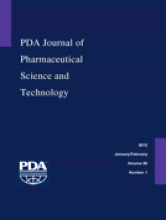Article CommentaryCommentary
Probability Concepts in Quality Risk Management
H. Gregg Claycamp
PDA Journal of Pharmaceutical Science and Technology January 2012, 66 (1) 78-89; DOI: https://doi.org/10.5731/pdajpst.2012.00801

References
- 1.↵
- Mlodinow L.
- 2.↵
- Singpurwalla N. D.,
- Wilson A. G.
- 3.↵
- Bernstein P.
- 4.↵
- Visschers V. H.,
- Meertens R. M.,
- Passchier W. W.,
- de Vries N. N.
- 5.↵
- Gigerenzer G.,
- Hertwig R.,
- van den Broek E.,
- Fasolo B.,
- Katsikopoulos K. V.
- 6.↵
- Pearl J.
- 7.↵
- Anonymous
- 8.↵
- Ayyub B. M.
- 9.↵
- 10.↵
Quality Risk Management Q9, ICH Harmonised Tripartite Guideline. International Conference on Harmonisation of Technical Requirements for Registration of Pharmaceuticals for Human Use (ICH), 2005. http://www.ich.org/fileadmin/Public_Web_Site/ICH_Products/Guidelines/Quality/Q9/Step4/Q9_Guideline.pdf (accessed April 19, 2011).
- 11.↵
Food and Drug Administration (FDA). Guidance for Industry Q9 Quality Risk Management. Center for Drug Evaluation and Research (CDER) and Center for Biologics Evaluation and Research (CBER), 2006.
- 12.↵
International Standards Organization (ISO). Application of Risk Management to Medical Devices,International Standard ISO14971:2000.
- 13.↵
ISO. Risk Management—Principles and Guidelines. International Standard ISO 31000:2009(E).
- 14.↵
- Aven T.,
- Renn O.
- 15.↵
- Hubbard D. G.
- 16.↵
- Savage S. L.
- 17.↵
- 18.↵
- Kahneman D.,
- Slovic P.,
- Tversky A.
- 19.↵
- Mauboussin M. J.
- 20.↵
- Ariely D.
- 21.↵
- Hubbard D. L.
- 22.↵
- Jaffe J.,
- Stavins R. N.
- 23.↵
- Morgan M. G.,
- Henrion M.
- 24.↵
- Keeney R. L.
- 25.↵
- Thornton A. C.
- 26.↵
- Claycamp H. G.
- 27.↵
ICH. Pharmaceutical Development Q8(R2), ICH Harmonised Tripartite Guideline, Current Step 4 version, August 2009. http://www.ich.org/products/guidelines/quality/article/quality-guidelines.html (accessed July 20, 2011).
- 28.↵
ICH. Development and Manufacture of Drug Substances (Chemical Entities and Biotechnological/Biological Entities), Draft Consensus Guideline, Current Step 2 version, May 2011. http://www.ich.org/products/guidelines/quality/article/quality-guidelines.html (accessed July 20, 2011).
- 29.↵
- Harry M.,
- Schroeder R.
- 30.↵
- Vose D.
- 31.↵
- Claycamp H. G.
- 32.↵
- Haimes Y. Y.
- 33.↵
- Linkov I.,
- Satterstrom F. K.,
- Kiker G.,
- Batchelor C.,
- Bridges T.,
- Ferguson E.
- 34.↵
- Haimes Y. Y.,
- Kaplan S.,
- Lambert J. H.
- 35.↵
- 36.↵
- O'Hagan A.,
- Buck C. E.,
- Daneshkhah A.,
- Eiser J. R.,
- Garthwaite P. H.,
- Jenkinson D. J.,
- Oakley J. E.,
- Rakow T.
- 37.↵
- Cox L. A. Jr..
- 38.↵
- Taleb N. N.
- 39.↵
- Ishikawa K.
- 40.↵
U.S. Department of Energy. DOE Guideline. Root Cause Analysis Guidance Document, Office of Nuclear Energy, Office of Nuclear Energy Safety Policy and Standards: Washington, DC, 1992.
- 41.↵
- Stamatis D. H.
- 42.↵
- Rönninger S.,
- Holmes M.
- 43.↵
- Tran N. L.,
- Hasselbalch B.,
- Morgan K.,
- Claycamp G.
- 44.↵
- Ayyub B. M.
- 45.↵
- Morgan M. G.,
- Fischhoff B.,
- Bostrom A.,
- Atman C. J.
- 46.↵
- Brafman O.
- 47.↵
- Dieckmann N. F.,
- Slovic P.,
- Peters E. M.
- 48.↵
In This Issue
PDA Journal of Pharmaceutical Science and Technology
Vol. 66, Issue 1
January/February 2012
Probability Concepts in Quality Risk Management
H. Gregg Claycamp
PDA Journal of Pharmaceutical Science and Technology Jan 2012, 66 (1) 78-89; DOI: 10.5731/pdajpst.2012.00801
Jump to section
- Article
- Abstract
- Introduction
- Concepts of Probability
- Probability in the Language of Risk
- Probability for the Measurement of Uncertainty
- Probability Implementation in Various Quality Risk Management Tools
- Qualitative, Hierarchical Methods
- Ranking Methods
- Quantitative Methods
- Challenges in Probability Judgments
- Conclusion
- Conflict of Interest Declaration
- Acknowledgments
- References
- Figures & Data
- References
- Info & Metrics
Related Articles
- No related articles found.





